Domyślnie WordPress wyświetla twoje wpisy na blogu na stronie głównej. Jeśli jednak tworzysz witrynę internetową dla firmy lub po prostu chcesz dostosować własną stronę główną, możesz chcieć osobnej strony dla sekcji twojego bloga.
Taka konfiguracja nie tylko pomaga utrzymać stronę główną w czystości i skupieniu, ale także zapewnia dedykowaną przestrzeń dla czytelników, aby mogli zapoznać się z treścią twojego bloga.
Aby poprawić komfort użytkowania i utrzymać wyraźny nacisk na naszą ofertę, dodaliśmy oddzielne strony blogów na wielu witrynach internetowych naszych firm partnerskich, w tym WPForms, OptinMonster i All in One SEO. Umożliwia to odwiedzającym łatwy dostęp do treści bloga, przy jednoczesnym priorytetowym traktowaniu głównego celu, jakim jest promowanie naszych wtyczek.
W tym artykule pokażemy dwa sposoby na utworzenie osobnej strony dla wpisów na blogu w WordPress.

Dlaczego warto wyświetlać wpisy na blogu na osobnej stronie?
Strona główna to strona główna Twojej witryny internetowej WordPress i pierwsza strona, którą widzą odwiedzający. Domyślnie WordPress wyświetla twoje najnowsze wpisy na stronie głównej i ma to sens, jeśli prowadzisz bloga.
Ale nie zawsze jest to idealne rozwiązanie dla witryn internetowych małych firm. Prawdopodobnie będziesz potrzebował bardziej angażującej strony głównej, która opowie użytkownikom o twojej firmie, produktach i usługach, pozwoli im dowiedzieć się, jak się z tobą skontaktować i zwiększy konwersję sprzedaży.
Teraz, jeśli chcesz również prowadzić bloga na swojej witrynie internetowej, będziesz musiał udostępnić inną stronę, na której odwiedzający będą mogli przeczytać twoje wpisy.
Mając to na uwadze, pokażemy ci, jak łatwo utworzyć oddzielną stronę dla wpisów na blogu w WordPress.
W tym poradniku omówiliśmy dwie metody i możesz skorzystać z poniższych odnośników, aby przejść do wybranej przez siebie metody. Należy pamiętać, że druga metoda jest najprostsza i oferuje najwięcej konfiguratorów:
Film instruktażowy
Jeśli wolisz pisemne instrukcje, czytaj dalej.
Metoda 1: Tworzenie oddzielnych stron dla wpisów na blogu w WordPressie
Możesz utworzyć oddzielną stronę dla wpisów na blogu przy użyciu domyślnych ustawień WordPress.
Metoda ta wymaga jednak nieco więcej pracy niż metoda 2 i nie oferuje tak wielu opcji dostosowywania.
Tworzenie oddzielnej strony głównej i strony bloga
Po pierwsze, musisz utworzyć dwie oddzielne strony WordPress, które będą używane jako twoja strona główna i strona bloga.
Nie musisz dodawać żadnych treści do tych stron i możesz nadać im dowolną nazwę. Dla przykładu, niektóre witryny internetowe dla firm używają nazwy “Aktualności” dla strony bloga.

Po utworzeniu tych stron, przejdź na stronę Ustawienia ” Czytanie w obszarze administracyjnym WordPress.
Teraz, w sekcji zatytułowanej “Wyświetlanie twojej strony głównej”, musisz kliknąć przycisk “Strona statyczna”.
Następnie możesz wybrać strony Home i Blog, które utworzyłeś wcześniej. Następnie przewiń w dół i kliknij przycisk “Zapisz zmiany”.

Teraz, gdy przejdziesz do ekranu Strony ” Wszystkie strony z kokpitu WordPress, zobaczysz, że strona główna jest oznaczona jako “Strona główna”, a strona bloga jest oznaczona jako “Strona wpisów”.
Kliknij odnośnik “Zobacz” na stronie bloga, aby wyświetlić podgląd.

Wygląd tych stron zależy od twojego motywu WordPress i możesz chcieć skonfigurować te ustawienia.
Na przykład, jeśli twój motyw ma menu nawigacyjne, to powiadomienie, że WordPress automatycznie utworzył strony Blog i Strona główna. Jeśli nie, to zapoznaj się z naszym przewodnikiem dla początkujących, jak dodać menu nawigacyjne w WordPress.
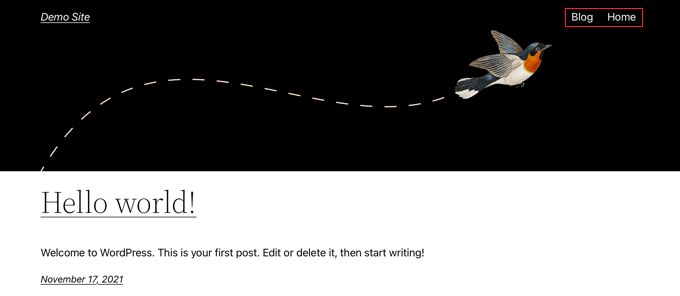
Dostosuj swoją stronę główną do własnych potrzeb
Jak dotąd, twoja nowa strona główna jest pusta. Teraz nadszedł czas, aby dodać informacje o Twojej firmie, produktach i usługach oraz poinformować odwiedzających, w jaki sposób mogą się z Tobą skontaktować.
Możesz dowiedzieć się, jak to zrobić w naszym przewodniku na temat tworzenia własnej strony głównej w WordPress. W Metodzie 1 pokazujemy, jak używać edytora bloków do dodawania obrazków okładek, kolumn, tabel, tekstu i multimediów, galerii i innych elementów.
Wiele kreatywnych pomysłów na konfigurator znajdziesz również w naszym przewodniku na temat tego, jak łatwo i skutecznie edytować stronę główną WordPress.
Dostosuj stronę swojego bloga do własnych potrzeb
Jeśli jesteś zadowolony z tego, jak wygląda twoja strona bloga, to twoja praca jest skończona.
Jeśli jednak obecnie korzystasz z motywu opartego na blokach, to możesz również dostosować konfigurator na swojej stronie bloga, przechodząc na ekran Wygląd ” Edytor z kokpitu WordPress.
Gdy już się tam znajdziesz, wybierz opcję “Strony” z lewej kolumny w pełnym edytorze witryny.

Spowoduje to otwarcie listy wszystkich stron twojej witryny internetowej w lewej kolumnie.
Z tego miejsca wybierz opcję strony “Blog”, a następnie kliknij podgląd strony po prawej stronie, aby rozpocząć konfigurowanie twojej strony bloga.

Możesz teraz kliknąć przycisk dodawania bloku “+” w lewym górnym rogu ekranu i dodać wybrane przez ciebie bloki do strony.
Dodatkowo możesz zmienić kolor tła, tekstu lub odnośników na twojej stronie bloga, klikając ikonkę “Style” w prawym górnym rogu ekranu.
Spowoduje to otwarcie panelu bloków po prawej stronie, z którego można kliknąć kartę “Typografia”, aby zmienić kolor tekstu, kartę “Kolory”, aby zmienić kolor tła, oraz kartę “Układ”, aby skonfigurować wymiary twojej strony bloga.

Po zakończeniu nie zapomnij kliknąć przycisku “Zapisz” u góry, aby zapisać twoje ustawienia.
Teraz możesz przejść na stronę twojego bloga WordPress, aby zobaczyć, jak wygląda.
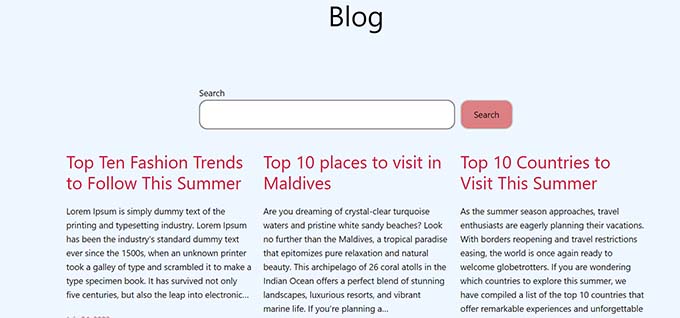
Jeśli jednak korzystasz z klasycznego motywu, będziesz musiał użyć metody 2, aby dostosować stronę wpisu na blogu.
Metoda 2: Tworzenie dostosowanej strony dla wpisów na blogu za pomocą narzędzia Drag & Drop Builder (zalecane)
Wtyczka do tworzenia motywów umożliwia łatwe tworzenie własnego motywu WordPress bez żadnego kodu. Obejmuje to możliwość tworzenia i dostosowywania oddzielnej strony dla wpisów na blogu.
Instalacja kreatora motywów SeedProd
Najpierw należy zainstalować i włączyć wtyczkę SeedProd. Aby uzyskać więcej informacji, zobacz nasz przewodnik krok po kroku, jak zainstalować wtyczkę WordPress.
SeedProd to najlepszy kreator stron WordPress typu “przeciągnij i upuść ” dla firm, blogerów i właścicieli witryn internetowych. Posiada również kreator motywów, który pozwala łatwo dostosować twoją stronę bloga i wiele więcej.
Więcej szczegółów można znaleźć w naszej pełnej recenzji SeedProd.
Po włączaniu przejdź na stronę SeedProd ” Ustawienia, aby wpisz klucz licencyjny. Informacje te można znaleźć na Twoim koncie w witrynie internetowej SeedProd.
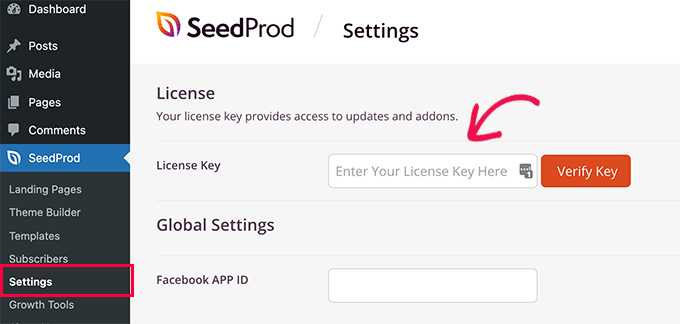
Następnie nadszedł czas na stworzenie własnego motywu WordPress. Jest to znacznie prostsze niż się wydaje.
Tworzenie własnego motywu WordPress
Najpierw należy przejść na stronę SeedProd ” Kreator motywów. Tutaj użyjesz jednego z gotowych motywów SeedProd jako punktu wyjścia. Pozwoli to zastąpić twój istniejący motyw WordPress nowym, dostosowanym projektem.
Można to zrobić, klikając przycisk “Motywy”.
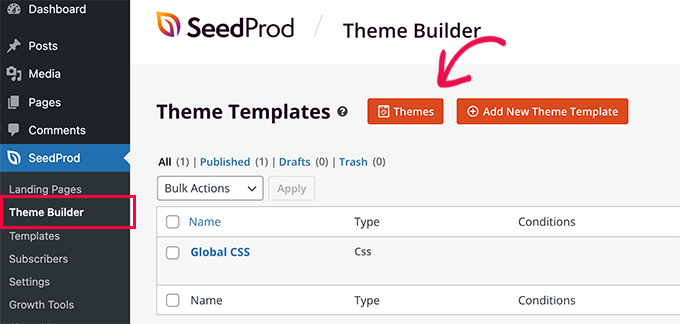
Zostanie wyświetlona lista profesjonalnie zaprojektowanych motywów przeznaczonych dla różnego rodzaju witryn internetowych.
Na przykład istnieją szablony o nazwach “Nowoczesny biznes”, “Agencja marketingowa” i “Motyw pośrednika hipotecznego”.
Zapoznaj się z opcjami i wybierz tę, która najlepiej odpowiada twoim potrzebom, klikając ikonkę znacznika wyboru.

Po wybraniu motywu, SeedProd wygeneruje wszystkie szablony motywów, w tym jeden dla indeksu twojego bloga i jeden dla twojej strony głównej.
Nie są to tylko puste strony, ale zawierają atrakcyjne układy i treści zastępcze, które można łatwo dostosować do własnych potrzeb.

W tym poradniku pokażemy, jak dostosować szablony strony głównej i indeksu bloga.
Możesz także dostosować inne szablony do własnych potrzeb. Aby dowiedzieć się, jak to zrobić, zapoznaj się z naszym przewodnikiem dla początkujących, jak łatwo stworzyć własny motyw WordPress.
Dostosuj swoją stronę główną do własnych potrzeb
Po wygenerowaniu twoich szablonów motywów możesz je edytować za pomocą kreatora motywów SeedProd. Zaczniemy od szablonu strony głównej.
Aby rozpocząć, wystarczy kliknąć odnośnik “Edytuj projekt” na stronie głównej.

Spowoduje to uruchomienie pliku szablonu w kreatorze motywów SeedProd.
Ten prosty kreator typu “przeciągnij i upuść” wyświetla podgląd na żywo twojej strony po prawej stronie i pasek narzędzi blokowych po lewej.
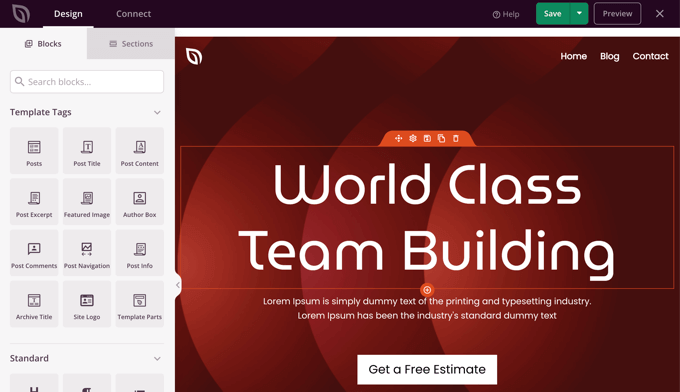
Możesz dostosować dowolny blok, klikając go, przeciągając bloki w górę i w dół za pomocą twojej myszy i dodając nowe bloki do strony.
Napisaliśmy kompletny przewodnik na temat tworzenia własnej strony głównej w WordPress. Po prostu przewiń w dół do metody 2, aby dowiedzieć się, jak dostosować twoją stronę główną za pomocą SeedProd.
Dostosuj stronę swojego bloga do własnych potrzeb
Kreator motywów SeedProd zapewnia również wiele sposobów na dostosowanie strony indeksu twojego bloga.
Zacznij od kliknięcia odnośnika “Edytuj projekt” pod stroną.

Zobaczysz ten sam panel podglądu po prawej stronie i pasek narzędzi po lewej. Stronę bloga można dostosować w taki sam sposób, jak stronę główną.
Na przykład po kliknięciu nagłówka można zobaczyć wszystkie jego ustawienia. Możesz edytować tekst, zmienić wyrównanie i wielkość pisma i wiele więcej.

Po zakończeniu należy kliknąć ikonkę “Bloki”, aby powrócić do paska narzędzi.
Kreator motywów SeedProd oferuje dodatkowe bloki fragmentów szablonu, takie jak blok Wpisy, który wyświetla listę zablokowanych wpisów na twoim blogu.
Blok Wpisy został już dodany do szablonu indeksu bloga dla Ciebie, a w tym szablonie blok wyświetla twoje wpisy w dwóch kolumnach. Możemy to zmienić na pojedynczą kolumnę.
Wystarczy kliknąć na wpis, a następnie zmienić ustawienie “Kolumny” na 1.
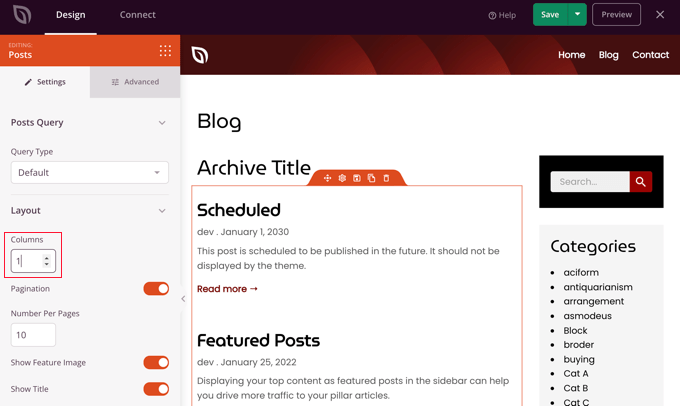
Układ natychmiast zmieni się na jednokolumnowy.
Przewijając w dół ustawienia bloku Wpisy, znajdziesz przełączniki, które pozwalają wybrać, czy wyświetlać obrazek wyróżniający i tytuł wpisu. Możesz także wybrać tagi nagłówka, które będą używane w tytule wpisu.
Dostępne są również opcje wyświetlania różnych metadanych wpisów. Możesz przełączać datę modyfikacji, autora, datę i godzinę publikacji oraz liczbę komentarzy.
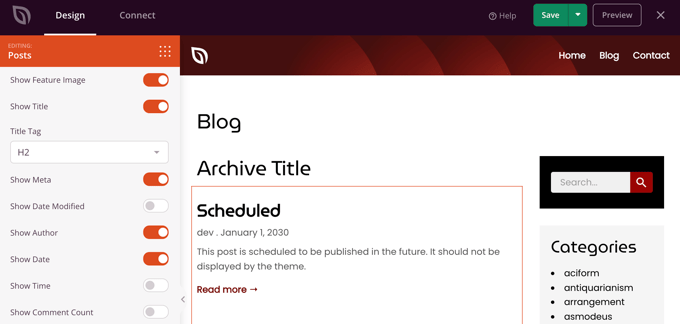
Oto kilka innych sposobów na dostosowanie indeksu twojego bloga:
- Indeks można filtrować według typu treści, kategorii, tagu lub autora.
- Kolejność sortowania wpisów można zmienić.
- Możesz wybrać liczbę wpisów wyświetlanych na stronie.
- Można przełączać zajawkę wpisu i dostosować jej długość.
Po zakończeniu konfiguratora własnej strony bloga, upewnij się, że kliknąłeś przycisk “Zapisz” u góry ekranu. Następnie możesz powrócić do listy szablonów, klikając ikonkę “X”.
Włączanie motywu SeedProd
Po zakończeniu konfigurowania szablonów motywów należy opublikować nowy motyw własny.
Wystarczy przełączyć ustawienie “Włącz motyw SeedProd” na pozycję “TAK”.

Natychmiast pojawi się powiadomienie o konieczności zmiany ustawień strony głównej i bloga WordPress. Po kliknięciu przycisku “OK” ustawienia te zostaną zmienione.
Możesz teraz przejść na swoją witrynę internetową, aby zobaczyć nową stronę główną i stronę bloga. Tak wygląda strona indeksu bloga na naszej witrynie demonstracyjnej.

Bonus: Wyświetl twoje ostatnie wpisy w WordPressie
Po utworzeniu osobnej strony z blogiem, możesz nadal wyświetlać kilka ostatnich wpisów na stronie głównej, aby zachęcić użytkowników do odkrywania większej części twojej witryny.
Aby to zrobić, otwórz swoją stronę główną w edytorze bloków WordPress. Gdy już się tam znajdziesz, kliknij przycisk “Dodaj blok” w lewym górnym rogu ekranu, aby otworzyć menu bloków.
Stąd wystarczy dodać blok “Najnowsze wpisy” do strony. Gdy to zrobisz, możesz dostosować listę ostatnich wpisów, aby wyświetlać zajawki, nazwiska autorów i daty zgodnie z twoimi upodobaniami.
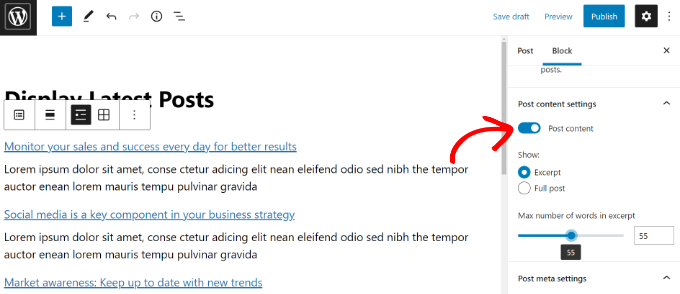
Na koniec kliknij przycisk “Opublikuj” u góry, aby zapisać twoje ustawienia. Teraz niektóre z twoich ostatnich wpisów będą nadal wyświetlane na stronie głównej, aby użytkownicy spędzali więcej czasu na twojej witrynie internetowej.
Więcej informacji można znaleźć w naszym poradniku na temat wyświetlania ostatnich wpisów w WordPress.
Mamy nadzieję, że ten poradnik pomógł ci dowiedzieć się, jak utworzyć osobną stronę dla wpisów na blogu w WordPress. Możesz również dowiedzieć się , jak dodać własny status wpisu dla wpisów na blogu w WordPress lub sprawdzić naszą listę najlepszych wtyczek powiązanych wpisów dla WordPress.
If you liked this article, then please subscribe to our YouTube Channel for WordPress video tutorials. You can also find us on Twitter and Facebook.





HP
Thank you!!!!!!
WPBeginner Staff
Simply go to Settings -> Permalinks and in the custom structure add this:
/blog/%postname%/
Braydan
How would I go about getting all “Posts” to display as “example.com/blog/my-blog-post” without having the pages of my website do the same?
Suvendra
Nice exactly what I was looking for
GO
Is there a way to post blog entries in different pages of the site? I would like to divide my blog into 3 section and post different blog entries in the different pages
Tom Durkin
Look at making a loop that only displays one category and then put those in custom templates for each of the pages.
Upasna
When I go to the ‘Template’ option, in the drop down list, there is no option for Front page Template..!! What do I do now??
Jess
I’m having the same problem
WPBeginner Support
If you do not see a Front Page Template, then this means that your theme does not have a template with this name. You can use a template provided by your theme or create a custom page template for your blog page.
Admin
ali
I make a blog in your described way but it goes to front page …..
means that when i click the blog in the menu it show the same page(front page).
i follow the exact way you mention in tutorial….
Please help.
bob
Great post. Thanks.
DrLightman
It works, expect in the case I want to use a custom template for the posts page.
Even if I’m allowed to pick the template when creating the Blog page, and I selecte this page in reading for posts, it seems WP always uses index.php instead of the custom template.
Ewa
I have the same problem and have no idea how to fix it Could anybody help..?
Could anybody help..?
Motener
Hi Sir/Mam
I NEED TO LEAR HOW TO MAKE A BLOG?
HOW I START?
WPBeginner Support
You can check out our guide on how to install WordPress, you can also take advantage of our free blog setup service.
Admin
Tash
Thank you for this! I’ve been working on creating a separate blog tab for my wordpress site and your process was outlined very well (easy to follow!). Thanks for help!
Shao
This was perfect, exactly what i needed. My previous sites used some complicated technique to show posts as a page. But using your method now shows a page with all our blog posts! So simple! Keep up the helpful tips. Am def coming back here if i run into any more issues with WordPress.
Matt
Thanks for this, it worked perfectly on my site using the default 2014 theme.
Ana Estrada
I tried adding the blog to my website, but I does not come out correctly. When I set the home page as the front page and the blog page as the post page, the content on the blog page is the exact same contact you see on my home page. How would I be able to fix this?
Mauro Mascia
Take a look at here:
http://codex.wordpress.org/images/1/18/Template_Hierarchy.png
and double check what template is used for the homepage and what is the default template.
In my case there was a home.php, which is used as default if no template is specified in the blog page.
Johanna
Thank you very much! This guide solved the exact problem I had.
Simon
Simple instructions but no results, doesnt work but thanks for trying
Edgar Lopez
Don’t say “it doesn’t work” when it obviously does based on the other comments. Sounds like it is user error.
Anastasia
I did that and lost my homepage :((( it says: 404 — Fancy meeting you here!
Don’t panic, we’ll get through this together. Let’s explore our options here.
I’m using Responsive theme… Please help!
Krish
Thank you
kyra
hi there… I am using the Customiz’r theme and I am not able to designate my homepage as an actual ‘page’. I want the homepage to be what it is now (see codecompliedcheck.com), but this page shows up in the menu as ‘Custom’, not as ‘Page’, so when I go to the setting to designate my actual homepage as the ‘static page’, it’s not even in the dropdown menu for me to choose. Which means that I’m not able to designate the ‘CCC Blog’ page I created as the ‘posts page’. Can you help me figure this out? Thanks in advance.
WPBeginner Support
Kyra, we don’t provide support for WordPress themes (because there are thousands of them). However, did you check theme customize screen located under Appearance » Themes » Customize. You will probably see front page options there.
Admin
Kelsey
Kyra did you figure it out? I am having the same problem.
Justin
I am having the same problem as Kyra and Kelsey. Any luck??
Digiwebpro
What about SEO? this page should be indexed? If the page shows the snippets of the posts, then is considerated like duplicate content? Thanks
WPBeginner Support
No if it shows snippets of posts, then it is not considered duplicate.
Admin
Arianne
How do you get snip it’s to show? I’ve gone to settings – reading -and checked summary, but my blog still shows the full length of the post.
WPBeginner Support
Check our guide on how to display post excerpts in WordPress themes.
edwin
Hi, thanks for your tutorial, I want to know if it´s posible to have two diferent pages showing diferent posts from a wordpress site. thanks.
WPBeginner Support
Yes it is possible.
Admin
Cheryl
How?
WPBeginner Support
Create a new template and use WP_Query to select the posts you want to display. We would try to cover this in a tutorial soon. see this:
Sam
Thanks for help.
Zeeshan
One more thing, i’ve asked for the help to support team and they told me to use Visual Composer to create that static home page and blog page, i don’t know how to use Visual Composer to create a static home page… If you are familiar with it then can you make a tutorial for that? It will be great if you make a tutorial for Visual Composer to create a static home page and blog pgae
WPBeginner Support
Zeeshan you need to create a new page. On the admin menu click on Pages and then on Add New. You will see that an editing interface will appear with a larger text box. This larger text box will have two buttons on top of it Visual and Text. The text editor is plain text editor with no styling buttons. The Visual editor has styling buttons and is supposed to be beginner friendly.
Admin
Zeeshan
Hi so would you please tell me any alternative or should i send you some screenshots to help me out further?
so would you please tell me any alternative or should i send you some screenshots to help me out further?
I’ve tried twice but it didn’t work for me coz there is no Front Page template exists in the theme, i am using Premium EffectiveNews theme from themesforest and i just wonder why it isn’t so modern lol… jokes apart anyways there are 6 templates exist in page attributes section 1-Default template 2-Authors 3-Contact us 4-Full width 5-Reviews 6-Sitemap… I’ve tried 2 times by selecting default template, disabled comments and trackbacks plus i changed Reading Settings also as static page, front page as “home” and posts page as “Blog” it didn’t work for me
WPBeginner Support
Please contact theme author for support
Admin
Todd
Hi-
I have a separate page for blog posts to appear, but the entire blog post appears (I’m displaying 10 at a time). How do I select just 55 words or such to appear instead of the entire blog post?
Thank you!
Todd
WPBeginner Support
Check out our guide on how to display post excerpts in WordPress themes.
Admin
Christine
Wow. Wonderful info. I still have a question. How can I create multiple blog pages? Is that possible? I would love to separate my blog posts by topic so I want to create multiple blog pages. Can you please help? Thank you.
WPBeginner Support
Christine to separate your blog into multiple pages by topics you already have Categories. You can then put those categories in your navigation menu from Appearance » Menus screen. If you want you can place categories as sub-menus under your blog page in the navigation menu.
Admin
Lucas
Simple and clear explanation.
Thanks for share
Luka
Hi,
I have difficulties with sliders now. Now the sliders from front static page are showing also in blog page and i don’t want slider there. Any idea how to remove sliders from blog page and still have blog page for posts?
Thanks!
G Bewley
Thank you very much!
Ryan McGovern
Thanks mate,
just what I needed.. so easy !!
Jason
Thanks so much
Becky
Thank you!
Davis Harrigan
I’m using Skylark as my theme – would these steps work to create a “custom”/another page where I can put posts?
WPBeginner Support
Yes, this should work fine on your theme.
Admin
Stuart
This article was so helpful! Thanks for putting it up!
Rick
How can I have some fixed introductory text on the blog page above the posts?
Thanks for your suggestionsa about creating the blog vs front page. Very helpful!
Leslie
Every time I search for help, I seem to run into one of your articles. They are very helpful! I’m hoping you may be able to work you magic on this problem….
A child theme was created specifically to help remove the page titles from showing up in the body of the site and remain solely in the tabs. This worked great until this week, the individual blog titles disappeared.
The code used is
.home h1.entry-title {
display: block;
}
Any suggestions?
Thank you.
WPBeginner Support
It is difficult to guess what could have gone wrong. Did you recently updated the parent or child theme or installed a new plugin?
Admin
Gauri
Great article. I am currently helping with a WP website where some posts were put up on a page. Now we want to stop posting on that page and post on another one, without losing the previous posts. How do i do that? Thanks.
WPBeginner Support
You can create a separate page. For example you had your posts on a page called Blog Posts and you want to move your posts to a new page called “News”. Then all you need to do is create a News page in WordPress. Go to Settings – Reading and select that page as your blog page. You can also create a custom page with a custom query to load only the specific posts on that page.
Admin
Kashif Khan
Awesome explanation in simple way.really very help full
Jenni
Thanks so much! I could work out how to write a page, and I could work out how to write a blog, but I could not work out how to write a blog in a page. Your step-by-step instructions worked perfectly. Another step in building my confidence, so thanks again
sommy uwakwe
Thanks for the article. I have created pages already and I want to be adding specific posts to specific pages. Like I have a page for music and poems so I want post music stuffs on the music page and poems on the other page. Please guide me through this
WPBeginner Support
Perhaps the best way to do this is by creating categories and using category archives.
Admin
Duska
Please, can you explain. I have categories, but can’t see how to use them for this. I want to choose before I click on publish button to which menu item to publish a post. Please, would you give specific steps for an example of this, or point to an article with explanation?
WPBeginner Support
You can add categories to your sidebar, from Appearance » Widgets screen. Click on Categories widget and drag and drop it to a sidebar and then preview your website. You can also add categories to your website’s navigation menu from Appearance » Menus screen.
Sonia
How do I get my blog posts to be housed under /blog/ (e.g. http://www.website.com/blog/blog-post-name)? If I write a post, I can’t do this and if I write a page, then it doesn’t function like a blog post (e.g. Not categorized, no date, no author).
jaiprakash
helpful indeed
thanks
Wesley
Thanks, bro!
Ignacio Castro
I have been using a WP theme called Customizr, and I haven’t figure it out how to get my blog up and running (I believe it’s a problem with the template, but it could just be me not knowing how to do it). Anyway, I will give it a try to the categories suggestion above, but is there a way to create a child page template that allows to get the posts into a page, if it doesn’t come with the theme? Thanks in advance.
Ignacio Castro
The categories option works, but I don’t like how the page looks, which again I think it depends on the theme you use. In mine, it basically shows a big Archive title at the beginning of the page, which doesn’t help much. Any feedback here is appreciated. Thanks.
Jahkie
this is actually pretty easy to follow..thanks
R Sharma
I used to have my blogs appear on a bespoke web page i.e. /whats-new/blog but after having a wordpress update they stopped appearing on the whats-new page but on a new page on their own i.e. /blog.
i tried what you’ve outlined above but cant get it to revert. Am i missing something?
WPBeginner Support
There could be quite a few reasons for that. First of all you should update your permalinks and see if this fixes the problem. If you are using a custom theme with homepage settings, then you should check those settings.
Admin
Jacobs
Nice one. Could you please suggest one or more themes that come with pages for blog posts, What I want is to be able to list topics of blogs related to every page on the page. For instance, I want to create pages for cars, boats and bikes. I want to have mysite.com/cars, mysite.com/boats, etc and I want blogs for each page listed accordingly. Please suggest any responsive theme that can do this. Thanks and cheers!
WPBeginner Support
You can easily do that by using categories. For example, you can publish posts in cars and boats categories and then add those categories to your WordPress Navigation menus from Appearance » Menus screen
Admin
paladin
Thanks for share
vico vo
Thanks. I turned off comment on page
Ankur Upadhyay
Thanks for this article. You made it look so easy. I will try it out on my blog.
Jigar Doshi
Very helpful indeed.
It is so much easier than I had thought it to be.
Thanks.